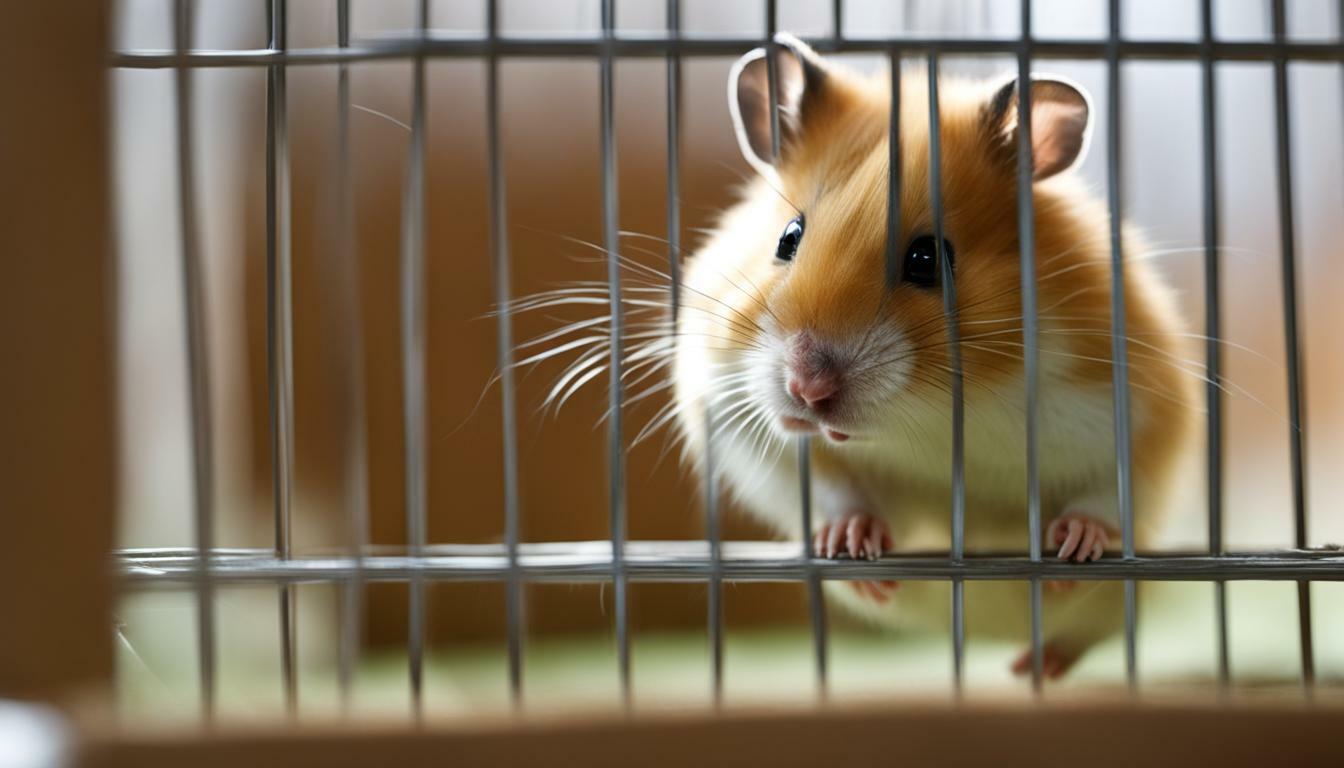If you’ve noticed your hamster scratching the walls of its cage, you may be wondering why this behavior is occurring. Hamsters are known for their active and curious nature, but excessive scratching can indicate an underlying issue. In this section, we will explore the reasons behind your hamster’s wall-scratching behavior and discuss potential causes that need attention.
Key Takeaways:
- Dry skin, mange, mites, fleas, and allergies are common reasons for hamster scratching.
- Dry skin can be treated with petroleum jelly.
- Mange and mites may require veterinary treatment with Ivermectin drops.
- Allergies should be diagnosed and treated to alleviate scratching.
- Providing suitable outlets, such as a scratching post, can prevent wall damage.
Understanding Hamster Behaviors
Hamsters are active animals that engage in various behaviors, such as scratching and climbing. These natural behaviors serve important purposes for their physical and mental well-being. Understanding these behaviors can help us better interpret why your hamster may be scratching the walls.
Scratching is a common behavior among hamsters. It helps them maintain their dental health by keeping their teeth in good condition. Hamsters have continuously growing teeth, so they need to chew and scratch on objects to wear them down. Scratching also helps them mark their territory and release excess energy.
Climbing is another natural behavior for hamsters. They have a strong instinct to explore their environment and seek higher ground. Climbing provides them with mental stimulation and exercise, and it allows them to escape potential predators in the wild. It’s not uncommon for hamsters to climb the walls of their cages, especially if they feel confined or bored.
To satisfy your hamster’s scratching and climbing instincts, it’s important to provide them with suitable outlets. A scratching post or a variety of chew toys can help divert their attention from the walls. This not only prevents damage to your home but also promotes their physical and mental well-being. Remember to choose safe and appropriate materials for your hamster’s toys to avoid any harm.
| Scratching and Climbing Behaviors | Reasons |
|---|---|
| Scratching | Maintain dental health, mark territory, release excess energy |
| Climbing | Explore environment, seek higher ground, mental stimulation |
Common Reasons for Hamster Scratching
Excessive scratching in hamsters can be attributed to several factors, including dry skin, mange, mites, fleas, or allergies. It’s important to understand these potential causes to address your hamster’s scratching behavior effectively.
Dry skin: Hamsters may develop dry skin due to a lack of humidity in their environment or a poor diet. Dry skin can cause itching, leading to excessive scratching. To alleviate dry skin, you can provide your hamster with a shallow dish of water for them to bathe in. Additionally, applying a small amount of petroleum jelly to their skin can help moisturize it.
Mange and mites: Mange is a skin condition caused by mites, which can lead to intense itching and scratching in hamsters. If you suspect mange or mites, it’s crucial to consult a veterinarian who can prescribe Ivermectin drops to treat the infestation. Regular cage cleaning and maintaining good hygiene practices can help prevent mites and mange.
Allergies: Just like humans, hamsters can develop allergies to certain substances, such as bedding materials or food. Allergies can cause itching and irritation, resulting in your hamster scratching excessively. If you suspect allergies, it’s essential to identify and remove the allergen from your hamster’s environment. Consulting with a veterinarian can help you determine the allergen and develop a suitable treatment plan.
To prevent your hamster from scratching the walls excessively and causing damage, providing suitable outlets for scratching is crucial. A scratching post is an excellent option that can redirect your hamster’s scratching behavior away from the walls. It’s also essential to ensure your hamster’s cage is enriched with toys and activities to keep them mentally and physically stimulated.
| Potential Causes | Treatment | Prevention |
|---|---|---|
| Dry skin | Apply petroleum jelly, provide water for bathing | Maintain proper humidity levels, feed a balanced diet |
| Mange and mites | Consult a veterinarian for Ivermectin drops | Clean the cage regularly, practice good hygiene |
| Allergies | Identify and remove the allergen, consult a veterinarian for further treatment | Avoid potential allergens, maintain a clean and dust-free environment |
By addressing the underlying causes of your hamster’s scratching behavior and providing suitable outlets for scratching, you can help ensure your furry friend stays happy and healthy.
Dry Skin as a Cause for Scratching
Dry skin is a common issue among hamsters and can lead to excessive scratching. Just like humans, hamsters can suffer from dry skin due to various reasons, such as low humidity or lack of proper grooming. It is important to address this issue promptly to ensure your furry friend’s comfort and well-being.
If you notice your hamster scratching excessively and their skin appearing flaky or rough, it may be a sign of dry skin. To alleviate this condition, you can apply a small amount of petroleum jelly to your hamster’s skin. This will help moisturize and soothe the dry skin, reducing the urge to scratch. However, be cautious not to apply too much petroleum jelly, as hamsters may groom themselves and ingest it, which can be harmful.
Additionally, ensuring a suitable humidity level in your hamster’s enclosure can help prevent dry skin. Hamsters thrive in environments with humidity levels between 30% and 50%. You can achieve this by placing a shallow dish of water near the cage or using a humidifier. Regular grooming sessions, such as brushing your hamster’s fur gently with a soft brush, can also help distribute natural oils and prevent skin dryness.
| Causes of Dry Skin | Treatment |
|---|---|
| Low humidity | Provide a shallow dish of water near the cage or use a humidifier |
| Lack of grooming | Regularly brush your hamster’s fur with a soft brush |
If your hamster’s dry skin persists or worsens despite these measures, it is recommended to consult a veterinarian. They can examine your hamster and prescribe appropriate treatment, such as medicated sprays or ointments. Remember, addressing dry skin promptly will help your hamster feel more comfortable and prevent further scratching.
Mange and Mites as Causes for Scratching
Mange and mites infestation can cause discomfort for your hamster, leading to excessive scratching. These microscopic parasites can burrow into your hamster’s skin, causing irritation and itchiness. If left untreated, mange and mites can lead to hair loss, skin infections, and even more severe health issues.
To address mange and mites, it is crucial to seek veterinary treatment. Your veterinarian may prescribe Ivermectin drops, a medication commonly used to treat these parasitic infestations in hamsters. They will guide you on the appropriate dosage and application method. It is essential to follow their instructions carefully to ensure the safety and well-being of your furry friend.
In addition to veterinary treatment, it is important to provide a clean and hygienic living environment for your hamster. Regularly clean the cage and bedding to minimize the risk of reinfestation. Thoroughly wash and disinfect any accessories or toys to eliminate any remaining parasites or eggs.
Tips to Prevent Mange and Mites
- Regularly inspect your hamster’s fur for any signs of mange or mites, such as redness, scabs, or hair loss.
- Keep your hamster’s living area clean and free from excessive moisture, as mites thrive in humid environments.
- Provide your hamster with a balanced diet and ensure they have access to fresh, clean water at all times to boost their immune system.
- Minimize contact with wild or infected animals, as they can transmit mites to your hamster.
By taking proactive measures and addressing mange and mites promptly, you can help relieve your hamster’s discomfort and prevent further scratching.
| Signs of Mange and Mites in Hamsters | Treatment |
|---|---|
| Redness, scabs, or hair loss on the skin | Veterinary treatment with Ivermectin drops |
| Increased scratching or excessive grooming | Clean and disinfect the hamster’s living area |
| Restlessness or changes in behavior | Provide a balanced diet and access to clean water |
Addressing Fleas in Hamsters
Fleas can be a bothersome issue for your hamster, causing them to scratch incessantly. If you suspect that fleas are the culprit behind your hamster’s scratching behavior, it’s important to take action promptly to provide them with relief. Here are some steps you can take to address the issue:
- Isolate your hamster: To prevent fleas from spreading to other pets or areas of your home, it’s crucial to isolate your hamster in a clean and secure environment.
- Consult a veterinarian: Schedule an appointment with a veterinarian who specializes in small animals. They will be able to diagnose the presence of fleas and recommend the appropriate treatment.
- Treatment options: The most common treatment for fleas in hamsters is the administration of Ivermectin drops. However, it’s important to consult a veterinarian for the correct dosage and application method.
- Clean the cage: Thoroughly clean your hamster’s cage and bedding to eliminate any fleas or flea eggs that may be present. Use hot water and mild detergent, ensuring to rinse everything thoroughly.
- Prevention: To protect your hamster from future flea infestations, it’s essential to regularly clean their cage, bedding, and toys. Additionally, you can use flea prevention products specifically designed for hamsters, such as flea drops or sprays.
Remember, fleas can cause discomfort and irritation for your hamster, so it’s crucial to address the issue promptly and provide them with the necessary treatment and preventive measures. By doing so, you can ensure your furry friend stays happy, healthy, and free from those pesky fleas!
| Key Steps to Address Fleas in Hamsters |
|---|
| Isolate your hamster |
| Consult a veterinarian |
| Treatment options |
| Clean the cage |
| Prevention |
Allergies and Scratching
Allergies can trigger scratching behavior in hamsters and require proper diagnosis and treatment. Just like humans, hamsters can develop allergies to various environmental factors, such as dust, pollen, or certain types of bedding. If your hamster is exhibiting excessive scratching, it’s important to consider allergies as a possible cause.
To pinpoint the source of the allergy, it’s recommended to consult with a veterinarian who specializes in small animal care. They will be able to perform tests to determine what your hamster is allergic to. Once the allergens are identified, steps can be taken to eliminate or minimize exposure to them.
In some cases, managing allergies in hamsters may involve changing their bedding material, avoiding certain foods, or providing an air purifier in their living space. The vet may also prescribe antihistamines or other medications to help alleviate the symptoms of the allergy and reduce the urge to scratch.
Common Allergens in Hamsters
| Allergen | Symptoms |
|---|---|
| Dust | Sneezing, watery eyes, nasal discharge |
| Pollen | Runny nose, itchy eyes, scratching |
| Food | Changes in appetite, digestive issues, scratching |
“If your hamster is exhibiting symptoms of allergies, it’s best to consult with a veterinarian for proper diagnosis and treatment options. Allergies can cause discomfort and distress for your furry friend, and addressing them promptly is crucial for their well-being.”
Providing Relief for Allergies
In addition to veterinary care, there are steps you can take at home to help relieve your hamster’s allergies. Keeping their living environment clean and free of dust and mold can help reduce allergen exposure. Regularly cleaning their cage, changing bedding, and keeping the air circulated can make a difference.
Another important aspect is to ensure that your hamster’s diet is well-balanced and free from any potential allergens. Opt for high-quality commercial hamster food and avoid feeding them human food or items that may contain common allergens like nuts or dairy.
By being proactive and attentive to your hamster’s allergies, you can help alleviate their discomfort and prevent excessive scratching. Remember, proper diagnosis and treatment are essential, so always consult with a veterinarian to ensure the well-being of your furry friend.
Providing Proper Outlets for Scratching
It’s crucial to offer your hamster appropriate outlets for scratching to redirect their behavior and prevent damage to the walls. Hamsters have a natural instinct to scratch and climb, and without suitable alternatives, they may resort to scratching their cage walls. By providing them with a designated scratching post, you can help satisfy their need to scratch and keep their paws away from your walls.
When choosing a scratching post, opt for one that is durable and tall enough for your hamster to stretch and reach comfortably. A post made of sisal, wood, or cardboard can be ideal for hamsters to scratch on. Additionally, consider placing the scratching post near their favorite activity or sleeping areas to encourage use.
Avoid placing the scratching post near their food or water sources, as hamsters tend to keep their eating and scratching areas separate. Keep in mind that some hamsters may prefer vertical scratching posts, while others may show a preference for horizontal ones, so choose accordingly.
| Benefits of Providing a Scratching Post: |
|---|
| Redirects their scratching behavior away from walls |
| Helps keep their claws healthy and trimmed |
| Provides mental and physical stimulation |
| Prevents cage damage and potential escape |
Creating a Hamster-Friendly Environment
Aside from a scratching post, there are other ways to create a hamster-friendly environment and minimize wall scratching. Ensure your hamster’s cage is appropriately sized and filled with toys and tunnels to keep them entertained. A lack of enrichment can lead to boredom and increased scratching behavior.
Regularly cleaning and refreshing your hamster’s bedding can also contribute to a healthier environment and reduce the risk of skin issues that may cause scratching. Lastly, pay attention to your hamster’s behavior and make sure they are getting enough exercise and mental stimulation through playtime outside their cage.
Hamster Nervous Behavior and Scratching
Nervous behavior in hamsters can manifest through excessive scratching, and it’s essential to understand the underlying causes. Hamsters are known to be sensitive creatures, and stress or anxiety can lead to increased scratching. If you notice your hamster constantly scratching the walls, it’s crucial to address the issue promptly to ensure their well-being.
Identifying the Causes
There are several factors that can contribute to a hamster’s nervous behavior and excessive scratching. Poor living conditions, such as small cages or lack of mental stimulation, can cause stress and anxiety in hamsters. Additionally, loud noises, sudden movements, or changes in their environment can trigger nervous behavior. It’s important to observe your hamster’s behavior closely and try to identify any potential stressors or triggers.
Managing Nervous Behavior
To help your hamster cope with their nervous behavior and reduce excessive scratching, there are steps you can take. First and foremost, ensure that their living environment is suitable and spacious enough to provide them with mental stimulation. Consider adding toys, tunnels, or a hamster wheel to keep them entertained. It’s also crucial to create a calm and quiet setting to minimize stress.
Another effective approach is to establish a routine for your hamster. Consistent feeding times and regular play sessions can provide a sense of security and stability. Additionally, handling your hamster gently and avoiding sudden movements can help them feel more at ease.
| Signs of Nervous Behavior | Solutions |
|---|---|
| Excessive scratching | Provide mental stimulation, create a calm environment |
| Running away or hiding | Handle gently, avoid sudden movements |
| Aggression or biting | Give them space and time to adjust, consult a veterinarian if necessary |
If your hamster’s nervous behavior persists or worsens despite your efforts, it’s recommended to consult with a veterinarian who specializes in small animals. They can provide further guidance and determine if there is an underlying health issue contributing to the behavior. Remember, creating a safe and comfortable environment for your hamster is key to promoting their overall well-being.
Nighttime Scratching and Sleep Disturbance
If your hamster is scratching the walls at night, it can be disruptive to your sleep routine and may indicate underlying issues. Hamsters are naturally active during the night, but excessive scratching can be a sign of discomfort or stress. Here are some possible reasons your hamster may be scratching the walls and tips on how to address this behavior.
Dry skin: Dry skin is a common cause of scratching in hamsters. To alleviate this, you can apply a small amount of petroleum jelly to your hamster’s skin. This can help moisturize the dry areas and provide relief from the itchiness.
Mange and mites: These parasites can cause intense itching and scratching in hamsters. If you suspect your hamster has mange or mites, it’s important to consult a veterinarian. They may prescribe Ivermectin drops, which can effectively eliminate these parasites and alleviate the scratching.
Allergies: Hamsters can develop allergies to certain foods, bedding materials, or environmental factors. If you suspect your hamster has allergies, try to identify the allergen and remove it from their environment. Consulting a veterinarian can help you determine the best course of action to manage and treat your hamster’s allergies.
| Reasons for Hamster Scratching at Night | Treatment |
|---|---|
| Dry skin | Apply petroleum jelly to moisturize the skin |
| Mange and mites | Consult a veterinarian for Ivermectin drops |
| Allergies | Identify and remove allergens from the environment |
Aside from addressing the underlying causes of your hamster’s scratching, it’s important to provide them with suitable outlets for scratching. A scratching post or a wooden chew toy can redirect their scratching behavior and prevent damage to the walls. Additionally, ensuring your hamster’s cage is enriched with toys, tunnels, and hiding spots can help reduce stress and promote a more relaxed nighttime routine. By addressing the reasons behind your hamster’s scratching and providing them with the right environment, you can help improve both their well-being and your sleep quality.
Tips to Stop Hamster from Scratching Walls
If you want to prevent your hamster from scratching the walls, there are several steps you can take to redirect their behavior and create a more comfortable environment.
Firstly, it’s important to provide your hamster with suitable outlets for scratching. A scratching post is an ideal option as it allows them to indulge in their natural instinct to scratch and climb. Place the scratching post in their cage or play area, making it easily accessible for them. You can also consider adding some enticing treats or toys to encourage them to use the post instead of the walls.
Secondly, if you suspect that your hamster’s scratching is due to dry skin, you can apply a small amount of petroleum jelly on their skin. This can help to moisturize their skin and alleviate any discomfort. However, it’s important to be cautious and only use a minimal amount, as excessive application can lead to greasiness and other issues.
If the scratching persists or you notice any signs of mange, mites, or fleas, it’s crucial to seek veterinary advice. A veterinarian will be able to diagnose the specific issue and prescribe appropriate treatment. For mange and mites, Ivermectin drops are commonly used to eliminate these parasites. Treating any underlying issues will not only alleviate your hamster’s scratching but also ensure their overall well-being.
In addition to addressing the potential causes of scratching, it’s important to create a calm and stress-free environment for your hamster. Keep their cage clean and provide ample opportunities for exercise and mental stimulation. Avoid sudden loud noises or disturbances that may make them anxious and trigger scratching behavior.
| Summary |
|---|
| To prevent your hamster from scratching the walls: |
| – Provide a scratching post as a suitable outlet for scratching |
| – Apply a small amount of petroleum jelly for dry skin |
| – Seek veterinary advice for underlying issues like mange, mites, or fleas |
| – Create a calm and stress-free environment for your hamster |
Conclusion
Understanding why your hamster is scratching the walls is crucial for promoting their well-being and ensuring a comfortable environment. Hamsters may scratch the walls due to various reasons, such as dry skin, mange, mites, fleas, or allergies. Identifying the underlying cause is essential in addressing this behavior and providing the necessary treatment.
If dry skin is the culprit, applying petroleum jelly to affected areas can help alleviate discomfort. However, if the scratching persists or worsens, it is recommended to seek veterinary advice for further evaluation and treatment.
In cases of mange and mites, a veterinarian may prescribe Ivermectin drops to effectively eliminate these parasites. Additionally, if your hamster is displaying allergy symptoms, such as persistent scratching, it is important to identify the allergen and take appropriate measures to manage and treat the allergies.
To prevent wall damage and redirect your hamster’s scratching behavior, providing suitable outlets for scratching is crucial. Incorporating a hamster scratching post into their enclosure can satisfy their natural instinct to scratch and climb, while minimizing the potential for wall damage.
By understanding the reasons behind your hamster’s scratching behavior and taking appropriate actions, you can ensure their comfort and well-being. Remember to regularly monitor their behavior and consult a veterinarian if you have any concerns or if the scratching persists despite your efforts.
FAQ
Why is my hamster scratching the walls?
Hamsters may scratch the walls due to various reasons, including dry skin, mange, mites, fleas, or allergies.
How can I treat my hamster’s dry skin?
Dry skin can be treated with petroleum jelly. Apply a small amount to your hamster’s skin, avoiding the eyes and ears.
What should I do if my hamster has mange or mites?
Mange and mites require veterinary treatment. Consult your veterinarian who may prescribe Ivermectin drops for your hamster.
Can allergies cause my hamster to scratch?
Yes, allergies can cause scratching in hamsters. It is important to diagnose and treat allergies to alleviate your hamster’s discomfort.
How can I prevent my hamster from damaging the walls?
Provide proper outlets for scratching, such as a scratching post, to redirect your hamster’s behavior and prevent damage to the walls.




